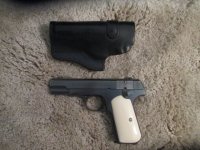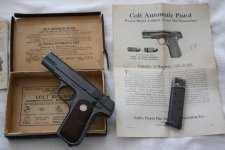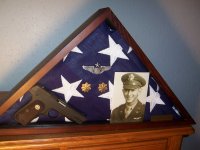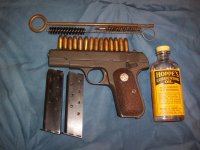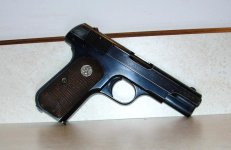This is a preview of a coming article - as usual, comments are welcome. Hope you find it interesting.
John
Folks as diverse as gangster Al Capone and General George S. Patton Jr. carried these little .32 Colt automatics for personal protection. Throughout the first half of the 20th Century, they were the gold standard for discreet carry. Flat, concealable, easy to draw, accurate and reliable, they were immensely popular. The U.S. military services adopted them as standard issue sidearms for flag officers. Even today, 60 plus years after production ceased, they are still popular and good examples of the Colt .32 hammerless pocket pistol are in high demand. More modern pistols have never fully supplanted them, and the design is secure as one of the major all-time stars of the pocket pistol niche.
Master gun designer John Browning had made agreements in the late 19th Century with Fabrique Nationale (FN) in Belgium and with Colt in the U.S. to manufacture his pistol designs. FN had exclusive rights to market their blowback pistols in Europe, and Colt was authorized to do the same with recoil-operated pistols in the U.S. One of FN’s most popular Browning-designed pistols was their 1899/1900 Browning semiautomatic blowback pistol in .32 ACP caliber. FN was also beginning to make a scaled-up version in 9mm Browning Long, the 1902/1903 “Grand Modele.” Since FN held those patents and had the exclusive right to make the pistols, Colt was left hanging in the U.S. They quickly asked Browning to patent a modified FN design in the United States and let them manufacture a .32 blowback pistol on these shores. Browning tweaked his design only slightly by modifying the barrel bushing. The appropriate patents were filed by Colt on April 3, 1902, and granted on December 22, 1903. Colt was quite confident of securing the U.S. patent and began tooling up in late 1902. Production began on the “Colt Automatic Pistol, Pocket Model” in June of 1903 and sales began in August of that year. Colt had an existing Browning recoil-operated design (in .38 ACP caliber) that utilized an external hammer which was also called a Model 1903. To distinguish this newer pistol, they regularly referred to it as the “Colt Hammerless.” The design actually had an internal hammer. At the Colt factory, the working designation was the “Model M.” Negotiating in early 1902 and then in an agreement dated January 11, 1902, John and Matthew Browning sealed compensation particulars with Colt. The terms included a 40-cent royalty on each .32 automatic pistol made, and a mandate on Colt to make at least 100 pistols a day at a cost which would enable competitive pricing with revolvers in the U.S. while maintaining high quality of materials and workmanship.
The resulting pistol’s prototype was essentially based on features in the Belgian-made Grand Modelle, and differed in only minor details from the later production pieces. The grips were checkered wood instead of the eventual molded black hard rubber types, and the manual safety was a bit larger than that eventually used. Colt chose .32 ACP (7.65 mm) as the caliber for this scaled-down version of the FN G.M. This semi-rimmed cartridge was designed by Browning, first made by Winchester Repeating Arms’ ammunition group, and was subsequently used by both FN and Colt.
The first mention of this new hammerless model was in an article appearing in the July 16, 1903 issue of Shooting & Fishing magazine. The initial month’s sales in August were quite strong, and the pistol became successful from the start.
The gun’s hallmark was its simplicity, a feature of most Browning designs. It incorporated a grip safety, a new feature among pocket pistols of the day. Field stripping was a snap. The gun had the recoil spring mounted under the barrel, and the barrel itself was secured firmly to the frame by lugs on the barrel which fit into grooves in the frame. The hammer, all springs and the disconnector mechanism were located behind the magazine well, as was the grip safety. The magazine release was located in the heel of the grip frame. There was no automatic last-round hold-open device, but the manual safety doubled as a slide lock. The single-stack magazine had a capacity of eight rounds. The trigger and manual safety had a special fire blue color. The quality of its materials, fitting and finish were all first-rate. In 1908, a .380 ACP version appeared, differing only in the bore, the magazine, the extractor, and the width of the magazine well. The .380 version could easily be converted to .32, while converting the .32 to .380 was somewhat more difficult to accomplish.
The Model 1903 .32 Pocket Hammerless pistols had a production run spanning 43 years, from 1903 until 1946. Some guns were later assembled from existing parts and sold through 1953. There were some major variations along the way. The first guns (serial numbered 1 to 71,999) had four-inch barrels and a separate barrel bushing similar to the one used on the Model 1911 .45 pistol. Checkered hard rubber grips with “Colt” enclosed in scalloped bands near the top were standard. The “rampant Colt” logo was molded into the grips near the bottom. The second type (serialed from 72,000 to 105,000) saw a reduction in barrel length from four to 3 ¼ inches. At serial number 95,801, the extractor was widened to accommodate both .32 and .380 cartridges. A third type (serialed 105,051 to 468,097) eliminated the barrel bushing and a lug was added to bottom of the barrel near the muzzle to fill the resulting gap and keep it locked into place. This version, in 1911, saw the scalloped bands enclosing the word “Colt” on the grips changed to straight bands. The pistol illustrated is of this type and was manufactured in July, 1918. Other minor changes were made in this series. In 1924, checkered wooden grips with a Colt medallion became standard, and in 1926 the rear sight notch was made square rather than “U”-shaped. A fourth variation added a George Tansley-designed magazine disconnect safety in 1926. The fifth variation was the WWII version, the majority of which had Parkerized finishes. These serial numbers ran from 554,100 to 568,834. .380 versions from serial 134,100 to 137,484 fell into this category. Pistols from these production runs were used by flag officers and other special military units where smaller size and concealment were considerations. .32 and .380 pocket hammerless pistols found favor in Great Britain as well, and numerous pistols were sold to the British in both WWI and WWII. The French ordered a number of .380 guns in 1942 for use in Shanghai, China. These guns had lanyard rings and were marked “CONCESSION FRANCAISE CHANGHAI.”
Field stripping the 1903 Hammerless for cleaning is fairly straightforward. Remove the magazine and clear the chamber. Be sure the manual safety is depressed and draw the slide back until the arrow on the right front of the slide matches up with the front of the frame. Twist the barrel counterclockwise (viewed from the front), and the lugs on the barrel will rotate out of their grooves in the frame. Draw the slide and barrel assembly forward off the front of the frame. The barrel is then rotated to its original position and withdrawn from the slide.
These pistols were trend-setters with their hammerless configuration and grip safeties, prompting competing firms to scramble to adopt these features. Their production spanned most of the first half of the 20th Century, and they were among Colt’s best sellers. They occupy a strong and classic place in the history of semiautomatic pistol design and maintain their appeal and usefulness even today. One could still be well-armed with this pistol designed over 100 years ago, particularly with today’s improved ammunition.
(c) 2013 JLM


